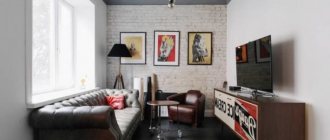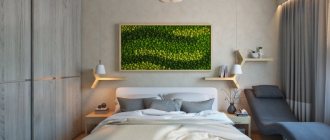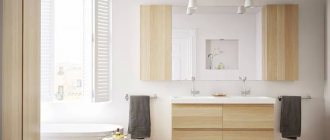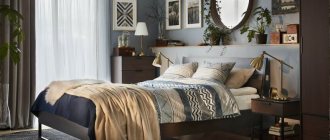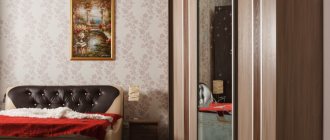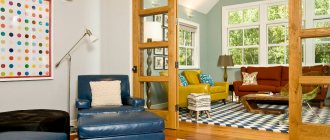At the final stage of renovation work, the question arises: “how to arrange the furniture in the room?” To do this, it is necessary to take into account many factors: the purpose of the room, operating conditions, requirements and functionality of furnishings, room parameters - its size and planning features, interior style and more. It is important that the furniture placed in the room makes it functional and at the same time visually spacious and cozy.
How to arrange furniture in a room?
Bedroom layout
Mastering spatial organization can be a difficult skill to master. For a bedroom, the basics are simple: you usually start with a single bed and adjacent bedside tables. But what about awkward angles? What if the room isn't big enough for two nightstands or a chest of drawers? What if the room is too long and leaves a lot of dead space? Where in the room should the rug be placed?
Interior of a narrow and long bedroom
Achieving the perfect bedroom layout may be easy in word but not in practice. However, with a few basic rules, you can optimize your bedroom furniture to create the perfect room. That's why I'm providing you with some basic layouts to help you choose the right plan.
Compact and roomy
Small-sized
Layout: If your bedroom can barely accommodate a bed, there are a few hacks to help you manage the space. While it's not advisable to push the bed against the wall, try leaving as little space as possible on one side - this will leave more space on the other end for a larger bedside table. A hanging shelf on the opposite side works great in tight corners.
Bed lighting for an airy space
Bed: Opt for a small double bed with built-in storage instead of a dresser.
Bed with large storage
Additionally: If you lack a large closet, choose clothes hangers. Place a small bench or chair next to them for any purpose, such as a spot for a bag, so that nothing ends up lying on the floor. Mirrors will also help a room look larger, so use multiple mirrors that can be placed strategically.
Full size
Layout: A large rug (20x30cm or larger) will help anchor the space. Choose matching nightstands and lamps that take up most of the wall, and a chest of drawers with an armchair on the opposite wall. This is a classic, reliable bedroom design that works like a charm.
Full size bedroom with furniture
Bed: A typical master bedroom, more or less square, should have enough space for a queen or king size bed.
Large space for a king size bed
Extras: If you have the space, a long bench at the foot of the bed will come in handy and is not only aesthetically pleasing but also comfortable.
Large bedroom with the necessary furniture
Long Layout
Layout: In a long, narrow room, it may be tempting to place the bed in the far corner, but try centering it along a long wall instead. Since the space is large, it will likely be difficult to find a rug that is the right size and they will usually be significantly more expensive. Instead, place your favorite rug on top of a less expensive extra large main rug. Instead of regular bedside tables, opt for larger chests of drawers that will really fill up the space.
Choose a large chest of drawers for storage
Bed: Choose a 2m x 2m king bed - you have room for it, so enjoy it!
It is better to choose a bed according to your height
Additionally: Large bedrooms often come with a walk-in closet, so ditch the chest of drawers in favor of more comfortable furniture. A reading nook, desk, bench, and large plant can help fill awkward corners. Assess your needs and plan your layout accordingly.
Allow yourself more with a huge bedroom
Basic rules and principles of placement
Designers advise placing cabinets so that they stand out as little as possible from other furniture. It is recommended that large cabinets be combined with other furniture , create a single composition or merge with the walls. This will reduce visual imbalance.
In some styles, for example, retro, country, glam vintage, the emphasis is on heavy, squat furniture. Then the wardrobes do not need to be disguised; on the contrary, they need to be placed in a visible place.
Advice
The basic rule when placing any cabinet is that it should not create obstacles when moving around the room, and not interfere with entry and exit from it.
Methods and features of furniture arrangement in a small room
Modern lighting in the hallway, how to arrange lamps to make the space look stylish 74 photos
Experts identify several ways to arrange furniture in a small room, such as:
- symmetrical method;
- asymmetric method;
- circular method.
Method of symmetrical arrangement of furniture in a small room
You can arrange furniture in the room using a symmetrical method. This method involves placing objects in pairs at equal distances on both sides of the center. In this case, the center of the arrangement is not considered to be the center of the room at all. They can be absolutely any part of the room. Sometimes even a corner can become a center with a symmetrical arrangement of furniture. Often the center of the living room is considered to be a TV, a bed is suitable for a bedroom, and a large table is the center of a dining room or kitchen.
Decorative elements can also be the center of the room. For example, these are large figurines or paintings. From this center it is necessary to place all objects in pairs at the same distance. The ideal option is when all the furniture is the same. For example, the same chairs near the TV or fireplace, the same type of cabinets near the bed, small tables around large furniture, etc. Experts allow for the use of different furniture, however, it must be the same size or have common decorated parts.
For the symmetrical arrangement method, items in the same style, made in the same color format, are most suitable. It is very difficult to fit furniture of different styles here. This rearrangement method can make the work of the owners of a small apartment easier. Because here you don’t have to think about where to put everything. You just need to choose the center and place the furniture at approximately the same distance from it. It should be taken into account that a symmetrical arrangement is suitable for rooms with the most regular geometric shape. This method will immediately reveal the slightest imperfections in the shape of the room. Such symmetry is often used in classic interiors, however, it looks elegant even in small rooms.
Method of asymmetrical furniture arrangement in a small room
The greatest advantage of this method is that it reduces all the shortcomings of the room. There is the possibility of combining items of different styles and shades. Large household appliances and furniture are usually placed near the wall, and small ones are placed as close to the center as possible. In a similar way, they are able to equalize in size. Large furniture is located in the distance, and small furniture is much closer.
The most difficult task in this case is the correct choice of viewpoint. It is customary to choose recreation areas in which people often spend their free time. For example, this could be a large sofa in the living room, a large bed in the bedroom, or a table in the dining room. But you need to walk around the room and examine the rearrangement of furniture from different points. It is necessary to arrange the furniture in a small room so that from most places in the room, the arrangement is the most harmonious.
Method of circular arrangement of furniture in a small room
For a circular arrangement of furniture in a small room, a table or chandelier is chosen as the center. Objects are located at the same distance from the center and create a fairly even circle. This circle is not always located in the center of the room. The most popular options are when many similar circles of objects are made in one room, none of which is located in the center of the room. These circles can have completely different decorative or stylistic characteristics. But this requires a fairly spacious room.
Arranging furniture in a circle can look great in both small and large rooms, however, this method eats up free space because it is often necessary to maintain considerable distances between objects and the center of the room. When the room is small, you need to adhere to minimalism in the environment. It is necessary that the amount of furniture be the smallest, but it will be comfortable and well-arranged. It is necessary to leave a lot of free space between objects for convenient passage through the room.
When the furniture is large, you need to leave more than one meter of free space around it. Arrangement in a circle is most popular in rooms with semicircular walls. If one of the walls of the room is made in a semicircle, then such an arrangement of objects can look very harmonious and beautiful.
What to consider when choosing a furniture arrangement method
Several universal rules will help you correctly arrange furniture in a room, which can be taken as a basis, taking into account the functional purpose of the room, its size and configuration, the location of window openings and doors, and the level of illumination.
You can determine the dimensions of the furniture by arranging it on a plan on a scale that will clearly show how much free space is left and what pieces of furniture it is advisable to discard
Step-by-step instructions for arranging furniture in a room
Table 1. Instructions for arranging furniture
| Illustration | Recommendations |
| Step 1: Draw a floor plan to scale | The choice of furniture designs depends on the size and planning features of the room. If there are niches or protrusions, it is better to make furniture according to an individual sketch. Determining the size will allow you to plan the room and furniture to scale, which can be moved, selecting the optimal location, taking into account the distance between individual elements, the availability of free space for opening doors and drawers, communication connections in the room, which should not be blocked by furnishings, making it difficult to comfortably and safe movement around the room. |
| Step 2: choose a functional dominant | Depending on the purpose, each room has a functional dominant. In the living room there is a TV, a fireplace area or an accent composition that attracts the main attention. In the bedroom there is a bed, in the dining room there is a dining table. |
| It is important, even in a small room, to maintain the optimal distance between individual elements and not pile them up. If the room is small, then the emphasis is on its purpose; secondary furnishings are selected depending on the availability of free space. Thus, the workplace can be built into a wardrobe or niche, the bedside table is replaced by a console plane with a hinged lid. |
| Step 4: choose a rational way to use the free space in the corners of the room | You should not ignore the corners in the room - you can place various functional items in them: TV - cabinet, shelving, dressing table, wardrobe, floor lamp. |
| Step 5: consider the optimal distance between furnishings | When creating a relaxation area in the living room, it should be taken into account that the optimal distance between furniture is from 0.6 to 0.8 m. Too close or, conversely, too far a distance will create discomfort. |
| Step 6: Use Visual Techniques to Expand Space | Don’t forget about ways to visually increase space - both the design (shape and color) of furniture and additional techniques can help with this: paintings are hung as high as possible, window decoration is done so that there is enough natural light in the room. To enhance the effect of free space, mirrors or mirror panels are hung opposite window openings. |
Note! The feeling of overload in the interior is created by small details in large quantities. Minimalist styles, on the contrary, visually increase the space. In a small room, it is recommended to choose light furniture in a laconic design.
Light furniture visually makes the room more spacious
The role of ergonomics
One of the most important tools used to create a functional, comfortable and safe living space is ergonomics. This science is used in the manufacture of furnishings and their arrangement in space, taking into account the anthropometry of a person and his actions.
Note! Ergonomics involves taking into account the anthropometric, psychophysiological and physiological characteristics of all family members and even the characteristics of keeping pets. This allows you to create a unique, rather than standard, living space that meets the needs of an individual person.
Choosing furniture parameters taking into account a person’s height
Thus, in families with children, the physiological characteristics of younger family members are taken into account, equipping the premises with additional hangers, shelves, chairs, tables, stands for the sink and toilet, corresponding to their height, and additional railings on the stairs. The situation is also the same with elderly family members - the space for them should be comfortable and safe, for example, handrails are installed in the bathroom, and the personal room of an elderly person in a two-story house is equipped on the ground floor.
Organization of communication connections in living space
When purchasing standard finished furniture, it should be taken into account that it is produced taking into account the average values of human anthropometric parameters. Some items are customizable. Often this is life-size children's furniture: chairs, desks, cabinets, beds, the size of which increases as the child grows.
Life-size furniture for schoolchildren
When making furniture to individual sizes, you must take into account the data of the person who will use it. It is important to choose the right height of a chair, bed or sofa, legs of a dining table or work table, and the height of a hanging shelf or mezzanine.
The main measurements you will need to take include the following.
Table 2. Basic measurements
| Illustration | Description |
| Required to select the seat height of the chair, which should be located on the same horizontal level as the level of the knees of a person in a sitting position. |
| Available space at arm's length in a seated position | Required to create optimal parameters for a workplace or recreation area. Ensures that necessary items are accessible while sitting. |
| Required to select the optimal height of the shelf or mezzanine. The most frequently used overhead shelf should be positioned at a height less than 20 cm from the highest point of reach in a standing position. |
| The height of the palm of the freely lowered arm in a standing position relative to the floor surface | Required to determine the optimal height of switches. |
| The height of the eye level of a sitting person relative to the floor surface | Required to determine the optimal location for the TV, while your head should be held straight or slightly lowered. |
Ergonomic requirements must be strictly applied when organizing the workspace in the kitchen. So, the distance between the hands and the tabletop should be 15 cm. The height of the working surface is calculated by bending the elbows at an angle of 90 degrees.
Kitchen furniture parameters depending on a person’s height
The basis of the kitchen work area is the refrigerator, sink and stove - it is in this sequence that they organize the correct technological process. Their arrangement forms a working triangle, in which there should be enough space for movement between the main elements.
Work triangle in the kitchen
Where to begin
Ceiling in the bathroom TOP-100 photos of design ideas
When it comes to arranging furniture, you may find yourself standing in an empty room for a long time and not knowing where to start. There are so many things to consider: personal aesthetic, lifestyle, budget and more, but the best place to start is with your furniture layout.
Furniture layouts for children's rooms
In other words, determining the placement of sofas, chairs, tables, storage cabinets and everything else that relates to the room layout (any item that touches the floor). I've put together a simple guide that works for every room in the house, starting with the living room. These living room arrangement ideas will make the job of organizing furniture and decorating your home easy and enjoyable.
Room plan for furniture arrangement
General concepts
First, let's figure out what primarily influences the choice of this or that furniture and the location of each item in space. We would highlight several of the most important criteria:
- functional purpose of the room;
- location of various light sources;
- location of window and door openings;
- room layout;
- room dimensions.
These are the basic points that will help us better navigate the space while arranging furniture, since they are the ones who make the most important adjustments in this process.
Seven times measure cut once
Tables from Ikea 80 photos from the 2016 catalog
So, the answers to the main questions have been found: you have approximately determined the dimensions of the future sofa, its shape and place in the room. Now it’s time to remember that you will have other furniture, and think about the relative position of the sofa relative to other interior items.
It is best to mark using a plan: on paper or in a special program. First, carefully draw a diagram, observing the dimensions and indicating windows, doors, heating radiators, and ventilation shafts. After that, try to draw the arrangement for all the furniture. The most convenient scale is 1:20.
Arrange the furniture so that it is convenient to approach it and that there is free space for opening closet doors and unfolding the bed. In this regard, a computer program is more convenient than pencil and paper, because everything in it can be moved with one mouse movement, and also shown in the form of a drawing and in the form of a 3D model.
It is not advisable to place the sofa close to the window opening, because it will cover the radiator and make it difficult to access the window for ventilation. Also make sure that it does not interfere with the opening of doors and balconies.
Drawing a plan is the best answer to the question of how to properly place a sofa: you will immediately understand what dimensions the model will suit you and whether it will be straight or angular. If you find it difficult to arrange furniture yourself, contact a designer for help.
Studio format
Today, many people strive for this format because it is convenient and allows you to create functional areas of any shape and size. This is the key to a harmonious interior, especially since any studio will allow you to easily organize three main zones:
- for sleep;
- for fun;
- for cooking food.
For a studio, all interior items are grouped by function, while the division of zones can only be done visually. Universal separation method:
- a TV with a cabinet forms the living room;
- a chest of drawers and a bed form the bedroom;
- shelves and a computer tabletop form an office;
- a suite and a dining table form the kitchen.
In this case, the arrangement should be such that all interior components do not block access to doors and windows. It is also possible to combine some areas using asymmetrical furniture arrangement. If there are large items, most often they are placed on the border with the kitchen, thereby demarcating zones and getting rid of large obstacles in the living room.
If the studio boasts not only a large area, but also high ceilings, it would be relevant to use tiered zoning, where the upper part contains a relaxation and sleeping area, and the lower part contains a living room and an office. Two-tier sleeping structures would be appropriate here, which will allow you to organize full-fledged sleeping places and an excellent storage system.
To more clearly delineate the kitchen, large furniture is used, but a bar counter or a rack with large cells will also cope with this task perfectly. An alternative is a tall chest of drawers or bedside tables arranged in a row. If it comes to a small studio, then the distinction is made with a movable screen or a regular curtain.
Arranging furniture in a small room
- Common mistakes
- The main rules for arranging furniture
- Narrow and long room
- What about Feng Shui?
Arranging furniture correctly in a small room is not an easy task.
In this case, you need to take into account many nuances at the same time, because every person wants his home to be stylish, beautiful, and functional. Also, the situation can be complicated by various factors, for example, the room may not only be small, but also narrow and long.
How to make a rearrangement in this case? Let's look at the basic tips and find out how to arrange furniture correctly.
Common mistakes
Before you make a change, you need to find out what typical mistakes owners of small apartments make. There are five main mistakes:
- Some people place all the furniture around the perimeter of the room, that is, under the wall. This method of rearrangement was popular in the USSR. When bulky sideboards and wardrobes were used everywhere. Nowadays, we need to get away from stereotypes.
- Leaving the center of the room empty is another common mistake. An empty center does not add free space to the room, it simply makes the entire composition disjointed.
- With a large amount of furniture, it would seem that everything is clear, but many still make this mistake.
- Light curtains on the windows are, of course, a wonderful technique, but if the room is too bright, such curtains will play a cruel joke on it. In this case, you need to use a denser window decor.
- Well, the main mistake is the abundance of trinkets. Many people gradually, without even noticing it, fill the room with soft toys, figurines, and useless souvenirs. All this greatly spoils the design of a small room.
The main rules for arranging furniture
To make the interior of a miniature room look harmonious, you need to follow the basic rules for arranging furniture. The designers have put together a selection of the most important tips:
- The furniture should not be wide, but tall. When buying, for example, a wardrobe, choose a narrow option that reaches the ceiling. You can place it in the interior without harming the design.
- It is better to refuse a standard bed. Give preference to a folding sofa. By the way, the sofa is different from the sofa. When choosing between a folding sofa and a book sofa, choose the second option.
- Add the most functional computer desk to your interior - narrow, but with many shelves tending upward and with a retractable keyboard stand.
- Be sure to place several hanging shelves in the room. They will not overload the interior, but will serve as an excellent storage place.
- If you can't do without a TV, choose an option that can be placed on the wall. By getting rid of the TV stand, you will save a lot of space.
- Use the windowsill to your advantage, because it is not just a stand for flowers. This is especially true if you have a wide window sill. You can create a full-fledged workplace on it.
- And finally, ditch the standard entry door to your room. Install a compact sliding door instead.
Narrow and long room
Arranging furniture in a narrow and long room is every designer’s nightmare. Be prepared to do a lot of rearranging before you figure out how to arrange your furniture without feeling like you're in a tunnel.
The most successful option for decorating a narrow and long room is to divide it into zones. In one part of the room you can arrange a dining area with a table and chairs, and in the other - a relaxation area, where an electric fireplace or TV will become the center of the composition.
Always avoid symmetry in a narrow and long room. This will only further emphasize her flaw. Asymmetry, on the contrary, will give the room a harmonious look.
In addition, there is one tricky trick that will make a narrow and long room look more square. To do this, you just need to paint the long walls in light colors, and the narrow ones in dark colors.
What about Feng Shui?
If you are a fan of Feng Shui, you should not renounce your philosophy. Even the smallest room can be rearranged according to this trend. For example, in a miniature bedroom the bed should be placed strictly with the head of the bed facing north. If it stands across the bedroom, it will only benefit the design.
Bedside tables are acceptable, but when choosing bedside tables that will be located near your bed, immediately abandon options with sharp corners. A mirror is an important attribute that can increase space. When arranging mirrors, remember the basic rule of Feng Shui: they should not reflect a sleeping person.
Some details about built-in wardrobes
Next we will talk about built-in wardrobes. They are very convenient, occupy unused space, so even very large ones do not look bulky. Free-standing cabinets are already equipped with shelves, drawers, sections, while built-in ones always correspond to your personal needs; you create their contents yourself. Built-in wardrobes allow you to mask layout flaws. The growing popularity of these models is easy to explain.
But before you invite a master, you must accurately calculate its dimensions and determine its location - it will be impossible to move it.
Built-in wardrobes come in several types:
- Direct. The simplest ones, suitable for any room.
- Corner ones are very compact, save space, and are suitable even for narrow rooms.
- Radial ones – these ones fit well into a niche.
The location of the cabinet also determines its contents. Will it be a linen closet for the bedroom, a wardrobe for the living room, or a wardrobe for outerwear in the hallway. When ordering a cabinet from a craftsman, you must clearly understand its contents: what shelves, drawers, holders and rods should be there. To do this, make a complete list of things and add about 20% for the expansion of your wardrobe. Next, group things according to the principle of storage - what will lie on the shelves, what will be in drawers, what will hang on hangers. Now it should be clear to you how many shelves and drawers you will need, and how long the bar should be. Two sizes of a built-in wardrobe are considered more or less constant: depth - at least 60 centimeters, otherwise you will not be able to hang hangers on the longitudinal rod; if you have sliding doors, then they will require another 8 centimeters for the mechanism; width 180-185 centimeters, this is dictated by the size of the doors. The height can be whatever you want, as the dimensions of your room allow.
Also think about the material for your closet in advance. You can choose from laminated chipboard, fiberboard, MDF and chipboard. The most popular is chipboard. It attracts with its durability, variety of design, resistance to mechanical stress and price.
Design highlights
Ergonomics of the available space. The first thing to consider is the future layout, taking into account sufficient free space. This is necessary for further movement without any difficulties.
If possible, furniture can be chosen in absolutely any style, the main thing is that it is correctly arranged.
If the room is narrow and elongated, then it is better to choose the simplest armchairs and a sofa, mainly a corner one; a coffee table or a cabinet according to the technique is also suitable. This can be seen in the photo of the rectangular living room.
Allocation of zones. Basically there should be several of them, but at least one. Carpets, end-to-end shelving or upholstered furniture pieces are perfect for dividing into zones.
Techniques for visual harmony. This is not a main rule, but can be taken into account if necessary:
The main emphasis is on a wide wall - it is necessary to visually increase the space and maximum proportionality. It should be original, for example, with photo wallpaper or a backlit niche. If the living room is rectangular in shape, then a large painting that can add some harmony would be an excellent solution.
Playing with color. Proportion can also be achieved with the help of unusual color solutions. For a narrow version, fairly light colors are more suitable, helping to visually enlarge the room. A wide variety of details can be bright. You can make a narrow wall in dark colors, which will make it closer, and then the room itself will have the correct shape.
Stripes. Mainly used for ceiling and floor coverings. For example, parquet boards, ceiling beams, lamps, carpets and many other details.
Kitchen furniture
The kitchen is the most difficult place to arrange furniture, since the room is often small in size. The ideal option is to arrange the kitchen unit in the letter “L”. This solution will make the room much more practical and compact. At the same time, there will be enough free space in the kitchen. C-shaped furniture arrangement is used only for large kitchens or irregularly shaped rooms.
Related article: Mansion of Garik Kharlamov [interior and exterior review]
Children's room areas
To arrange furniture, divide the room into zones: study, play, sleeping area and place for storing children's things.
- Study area
When planning this area, keep in mind that it is best to place the desk near the wall so that the child can see the front door. The edge of the table should be at the level of the baby's chest. The child must be able to support himself on the back of the chair. It would be nice to purchase transformable tables and chairs so that they can be adjusted depending on the height of the baby. For the study area, it is also worth purchasing a computer table with shelves where books, cups, photographs, and notepads can be stored.
- Game Zone
Various cabinets, shelves, and containers for toys are necessary for the baby in the play area. Such pieces of furniture will not clutter up the room and will teach him to be neat. For children under 10 years old, do not choose cabinets with glass doors. For two children, there should be two toy boxes in the play area.
- Sleeping area
A child needs comfort, so he must play, study and, of course, sleep in a comfortable zone. It follows that the crib must be placed in the right place and positioned so that the baby can see the front door. You cannot place it under windows or near heating radiators. The baby sofa is very comfortable for children. When unfolded, it serves as a full-fledged bed for the baby and takes up little space when assembled. A sliding partition will be very convenient in the sleeping area.
- Storing children's things
Every child should have a place to store toys, clothes, shoes, and bags. For this purpose, corner cabinets will be convenient, as they will take up very little free space.
Furniture selection
What furniture to choose to make it comfortable for children?
When choosing, be sure to pay attention to the material from which it is made. It is better, of course, to choose furniture made from natural wood, but if this is not possible, ask the seller to provide you with a document on the environmental safety of the material. Consider the size of the room when choosing furniture
For small rooms, modular furniture will be optimal, since it consists of several blocks combined.
Modular furniture
Such furniture has a number of advantages:
- Space saving. All angles are functionally involved.
- Independently compiling a unique design for a children's room.
- Financial savings. For the purchase of children's furniture separately, a larger amount is paid than for such a set.
Advantages and disadvantages of a bunk bed for brother and sister
Pros:
Space saving, which is very suitable for small apartments.
Minuses:
“Apple of discord” among children. Any child wants to take a place at the top. Therefore, parents should explain to the child this way: the place at the top is much more dangerous, so the older child will take it.
When choosing a model, pay attention to the size of the bed and the quality of the mattress. Also pay attention to the berths, which have auxiliary storage drawers
Such beds with lamps, shelves, and curtains are also interesting. There is another option that will cost a little more, but the nursery area will be used more efficiently
Order according to the size of the children's wall with built-in beds with cabinets and drawers. Pay important attention to the choice of beds, since the design of the children's interior depends on their distribution. In a room for mixed-sex children, you need to find a neutral design option
Ideas with photos on how to arrange furniture in a children's room
These ideas for storing toys are easy to implement, but how beautiful and original they look
This is how you can design your study space
Rooms for two children
What is ergonomics
The third stage is to involve science. Yes, yes, you can’t go anywhere without her. Ergonomics will help us. This is the science of the proper organization of space during human interaction with the environment. In other words, how to adapt the interior to suit yourself so that it is physiologically and psychologically comfortable? So, from an ergonomic point of view, it is necessary to take into account the following parameters:
- The dimensions and height of the furniture, taking into account this time the dimensions of a particular person, that is, yours.
- The location of door handles, switches, sockets so that it is convenient for you.
- Placement of light sources in a room depending on its functionality.
- Determine the optimal distance between furnishings.
- Ensure free and unhindered movement around the room.
Ergonomics helps make a typical room exactly yours, taking into account all anthropometric and physiological characteristics. Just remember to consider the needs of the rest of the family, especially children. Ergonomics advises to take even pets into account.
Choosing a sofa bed or a full sofa and bed in one room
If you are forced to combine a living room with a bedroom, then first you need to decide for yourself whether you will have a separate bed and sofa or whether you will use a sofa bed. With the latter, everything is clear, the design of such a room is no different from the design of an ordinary living room, except that you need to carefully choose a coffee table, preferably one that is on wheels, easily moves away and does not interfere with the unfolding of the bed. Personally, I am of the opinion that unfolding a sofa every day is a tedious task, plus it has a far from orthopedic surface and sleeping like that for many years in a row is clearly not good for your health. In the end, the sofa usually stands unfolded and folded 5 minutes before guests arrive. It turns out that on one side of the scale is your own back, and on the other is receiving guests once a month. The choice is yours.
And one more argument. Calculate how many hours a day (not during the day) you spend on the sofa bed in a sitting position, and how many lying down. I am 99% sure that it is used as a sleeping place at least 2, or even 3 times more. But at the same time, in terms of comfort it is inferior by the same 3 times to a good orthopedic mattress. Is there any logic to this?
Personally, when people ask me, I always advise, if possible, to install a full-size bed, and if nothing else fits in, then receive guests in the kitchen.
And in the end, if you came across this article, then most likely in your thoughts you have already given up the idea of sleeping on a folding sofa, right? Some small doubts remained: how to organize all this, will it work out well, will it look good... Right?
Of course, combining two functions in one room is always a search for some kind of compromise. It is unlikely that a large corner sofa with a chaise longue, a pair of armchairs and a large double bed 1.8 meters wide will fit at the same time. Something will have to be sacrificed.
Since when combining a living room and a bedroom, the room simultaneously performs several tasks, it is logical to allocate several functional zones there. We'll talk about how to do this further.
I’ll add right away that there are also such options as a roll-out bed from a podium or a bed that is stored in a closet. I do not consider them in this article, because... I find it inconvenient. It would be better to just have a sofa bed.
Furniture as an element of space zoning
Furniture often acts as an element that divides space into separate functional areas. For example, if there is a need to allocate a workplace in the living room or bedroom.
Workplace in the living room
In the spacious living room you can select a separate place for sleeping. In both cases, additional zones are located closer to the window, and to separate them, a through shelving or a low partition with a table top is used.
Bed in the living room
Also, the following can serve as an element for zoning space:
- Sliding partition.
- Screen.
- Rack.
- Closet.
- Arch.
- Bar counter.
- Curtain.
- Sofa.
Many housewives think about how to sew curtains with their own hands, because it is not always possible to buy a ready-made set that perfectly matches the color and texture of the rest of the textiles and wallpaper, and ordering from a studio is expensive and time-consuming. We will tell you about the main stages of tailoring and the principle of manufacturing some styles in a special article.
General recommendations for placement
Now let’s look at the standard rules for furniture placement, which we cannot do without, and which we most often carry out without thinking about them.
It is important to maintain the distance between the TV and the sofa; it should be such that it can be seen from all places. For example, a sofa and armchairs are placed opposite the TV. When designing zones in the living room, do not intersect them, but strictly separate one from the other. Do not block the path to the balcony or doors; everything should be within easy reach for safety reasons. Place furniture and furnishings so that they stand securely and do not fall to avoid injury. For the relaxation area, set aside the least lit place in the living room for maximum relaxation; in this area, place a sofa or armchairs, a TV, and use a sconce or floor lamp as lighting
The recreation area can have a fireplace, which brings an atmosphere of warmth and home. The dining area or dining room can be either in the middle of the living room or near the window; such an area requires good lighting. In a small room you should not place a large table; replace it with a folding table and a small coffee table.
Or maybe arrange it according to Feng Shui...
An ancient science such as Feng Shui teaches how to achieve harmony in your home and talks about how to properly place furniture in a room for receiving guests in order to receive an influx of positive energy.
According to Feng Shui customs, pieces of furniture should be placed as follows.
First, the central part of the room is decorated, first of all, by installing the main objects in the interior, a sofa or a soft corner. Upholstered furniture should not be too large so as not to disturb the proportions of the vital force of Qi in the living room. It is not recommended to place the largest furniture, shelving, cabinets, etc. near windows and close to the door, this is explained by the fact that tall furniture visually reduces the space for the penetration of positive energy. Therefore, place such furniture along a blank wall or give preference to corner cabinets. It is better to place all seating items facing the window, but in no case with your back to the door or window. This will serve as a barrier to the entry of energy. Choose tables for such a room without corners, preferably round in shape. To counteract evil spirits, it is not a bad idea to place pieces of furniture in a circle or in the shape of an octagon; in such an environment it will be easier to communicate. The western wall in the living room is best suited for placing TV and video equipment, but not opposite the window or door. To neutralize the negative energy of the TV, place a barrier of living plants and flowers nearby. According to Fei Shu, the presence of built-in furniture in which lighting can be made is not denied; according to the teaching, Qi energy will pass into it calmly. Give preference to furniture with legs, at least small ones, so that they do not touch the floor, this will facilitate the free passage of energy in all corners of the living room
This is especially important for the sofa on which you relax and sleep, as it greatly affects vigor and energy. The center of attention and attracting Qi in the living room can be a fireplace, a coffee table or some collection on the shelves of a cabinet with glass doors.
Thus, by carefully considering the placement of furniture in the living room, you will achieve not only beauty in the interior, but also comfort.
This is very important, since it will be comfortable not only for you, but also for your guests. Whatever rules you adhere to, try to bring something of your own, because the living room is a reflection of your own taste
Imagine a little and you will succeed.
How to choose a cabinet
Of course, you should start with the right choice of cabinet. What should you pay attention to? There are three types of cabinets:
- Freestanding.
- Built-in.
- Semi-built.
Free-standing are independent structures that can be rearranged and transported. It usually has standard dimensions and internal contents - shelves, drawers, rods.
Built-in wardrobes are good for rooms with niches. They often have only one wall - the front. The rest are the walls of the room. It allows you to use space very efficiently, but you cannot move it.
A semi-built-in wardrobe is something between a free-standing and a built-in one. Its frame is usually fixed to the wall and one or more walls may be missing. It is also impossible to move it.
Based on the method of opening doors, cabinets are divided into hinged and sliding. There are also accordion doors, roller shutter doors, overhead doors and other, more exotic options, but the most common are the first two. Wardrobes with hinged doors have an ancient history, but are still in demand today. The doors are attached with hinges to the frame, are easy to use and have a long service life. Loops by design can be:
- Overheads – or “butterflies”.
- Inset - located inside the case.
- Corner – designed for corner cabinets.
- Inverse - allow you to open the door 180 degrees.
For small rooms, hinged wardrobes are not very convenient because they require free space in front of the doors.
Wardrobes with sliding doors, or wardrobes, a relatively recent invention, quickly became fashionable due to their functionality and convenience. They do not require additional space to open the doors, so they are also suitable for very small rooms. The sliding system of the wardrobe can be either roller or hanging. The roller has two profiles - bottom and top, the rollers move along a guide, and the entire load falls on the lower part. With a suspended system, the only load-bearing element is the upper guide - a monorail along which the doors move. Guides are made of steel or aluminum alloys. Aluminum ones, of course, are lighter and more elegant, but in terms of durability and strength they are inferior to steel ones.
We've decided on the design, now we need to think about functionality. Agree that the closet in the hallway is different from the closet in the bedroom. This means that you must choose a cabinet for a specific room.
A wardrobe is suitable for the hallway, where clothes for different seasons will be stored, there should be shelves for shoes and compartments for shoe care products, hooks for bags, umbrellas, drawers for all sorts of small items.
For a closet in the living room, you can provide an open section for a TV, audio-video systems, a bookcase, and drawers for storing documents.
A closet is selected for the bedroom so that bed linen can be stored there - on shelves, underwear - in drawers, light clothes - on hangers.
A wardrobe in a nursery should be functional, comfortable, and bright. Its configuration can be changed as the child grows older. The cabinet fronts are made of washable materials.
Functionality
The living room can serve one or more functions. If there are several rooms in the apartment, then the living room will be used for its intended purpose: receiving and accommodating guests, a relaxation area for the whole family.
If the apartment is one-room, then “living room” is a relative concept. This is where household members sleep, watch TV, and work. Therefore, the furniture in such different living rooms will differ from each other.
About furniture for the living room, which does not combine any other functions, is more or less clear.
When it comes to a multifunctional room, you need to be smart to accommodate everything. Transformable or modular furniture will help out.
It is also important to consider the location of windows and doors in the living room.
Lighting and decor
Grouping furniture, in principle, will help avoid clutter. Agree, a comfortable soft corner for two, or maybe a whole company, is much nicer than a set of fashionable but impractical items.
The decor will help in arranging the necessary vertical accents.
Lighting is necessary both general and accentuating. We use floor lamps, wall and table lamps.
Plants, especially tall ones, are good not only for large rooms. They will brighten up the voids and significantly improve the overall appearance of the room.
Nuances of rearrangement depending on the type of furniture
How the furniture will be rearranged depends not only on the type of room, but also on the dimensions of the products themselves. Any item must be moved so as to maintain its integrity and not damage the floor covering. Also, we must not forget about our own safety.
Types of furniture staplers, their features and scope of application
Large
Heavy and large furniture in the apartment should be rearranged first. Otherwise, smaller structures will interfere with its movement. In this case, you need to follow a certain sequence of actions:
- Ask at least one other person for help.
- Place plastic covers under furniture legs to protect the flooring from unwanted scratches.
- Rub the floor with soap or wax.
- Slowly move one side, then the other.
- Use special mats to overcome rapids.
The main thing that can hinder trouble-free work is haste. It is better to spend more time rearranging furniture correctly than to subsequently eliminate scratches and dents.
Place plastic covers under the furniture legs Rub the floor with wax or soap Move the furniture one at a time Use special rugs
Small-sized
Rearranging small furniture is usually not difficult and does not require additional help. Products must be emptied of contents to reduce weight. Household appliances are disconnected from electricity before moving. The new place is pre-prepared for arrangement, and the path to it is cleared of unnecessary things.
Empty products from contents Disconnect household appliances from electricity Clear aisles
Headsets and kits
Interior design often uses large furniture structures consisting of several elements. As a rule, they are selected to suit a certain style, and if the apartment has a non-standard layout, they are made to order. If all the parts are securely fastened to each other, rearranging the furniture will require special tools and a lot of time. If you lack the necessary skills, you will have to seek professional help. It is much easier to modify a modular kit. Its individual parts can be easily rearranged from place to place.
Interior tricks for arranging cabinets
A wardrobe partition is another way to make it part of the interior. Such cabinets open on both sides and divide the room into two parts. Here it is better to choose a narrow and long model. If you leave a narrow passage, you will have two small rooms. A large, deep closet is not suitable for this purpose; it will only create an unnecessary obstacle.
To make the interior with the cabinet look harmonious, combine different materials in texture: glass and wood, metal and leather, porcelain and plants. If your plans do not necessarily include hiding the cabinet, then combine matte and glossy surfaces and make eye-catching fittings. Do not furnish the room with monotonous furniture, it makes you sad. Combine colors, play with shades.
No. 5. How to arrange storage areas correctly?
Some living rooms double as dressing rooms, since many apartments no longer have space for storing clothes. Owners of spacious rooms can place only a couple of floor cabinets to accommodate all the necessary small items and supplement them with a couple of shelves. Everything is much more complicated if there is not much space, and it needs to be organized so that everything you need fits, and the living room remains bright and uncluttered, and does not resemble a closet.
Modern designers unanimously advise abandoning traditional walls and opting for other, more airy, but no less spacious options. So, all things with shoes and even some household electrical appliances will fit in a spacious wardrobe - the main thing is to organize its space correctly. You need to place it in the living room so that it does not immediately catch the eye of someone entering the room, but it is better to leave the remaining walls as free as possible.
It is better to use a minimum of tall furniture , and leave one of the walls empty or only half closed. This could be the wall behind the sofa or opposite it. Of high furniture, it is better to use only shelving , which, together with storage, can perform the function of zoning space and separating, for example, a recreation area from an office, and all the necessary stationery, books, etc. and will be placed on the shelves of the rack, which does not become a blank partition.
For small living rooms, they offer a few more tricks in arranging storage spaces. So, a sofa can be placed at a short distance from the wall, and behind it, for example, cargo racks, such as kitchen ones, can be placed. This option is acceptable if there is space to extend such shelves. In addition, you can use niches in sofas, armchairs and poufs .
Basic principles of room zoning
Before arranging furniture in a room, be sure to study the principles of room zoning in order to do it correctly. For zoning purposes you can:
- build an arch;
- install partitions;
- buy shelving;
- move the cabinet;
- make a screen;
- use curtains.
When zoning, you can use different color schemes in individual zones. As well as different finishes, decorative components, height of objects. Screens are best installed in small rooms. For large rooms it is better to make a full-fledged partition.
No. 6. Space for additional zones
You can organize a compact workplace . To do this, you can use a corner computer desk, but it is better to place it closer to the window. All the necessary accessories will be located on the shelves of the table; you can use a couple of wall shelves or the rack mentioned above.
If the living room is combined with a bedroom , then it is better to place the bed away from the entrance to the room, fence it off with a screen, curtain, closet, or shelf system. Often the living room also plays the role of a dining room . In this case, it is better to place the dining table at a minimum distance from the kitchen, and furniture, for example, a sofa or chair with its back turned, is optimal for zoning.
